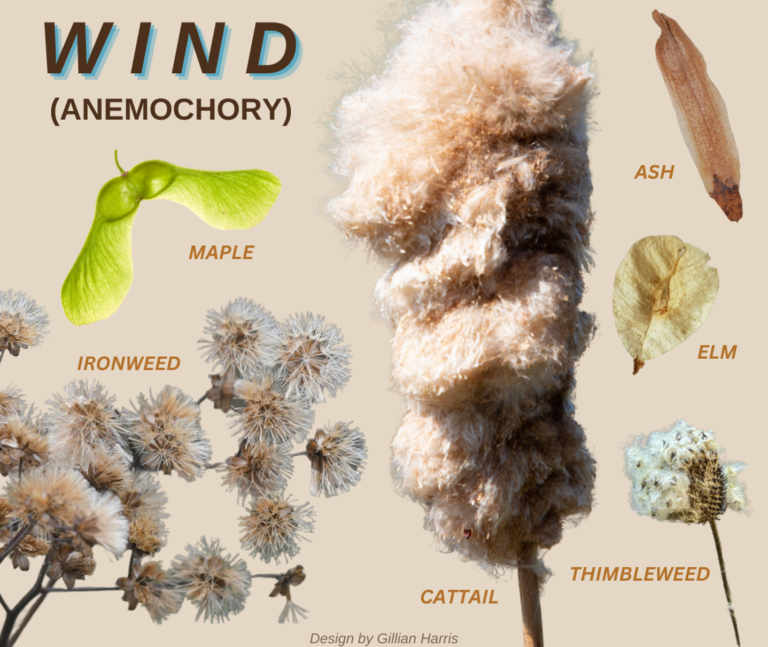Seed dispersal is the movement of seeds from their place of origin to a new site where they can germinate and grow. It is a vital step in a plant's life cycle, influencing species distribution, population dynamics, and ecosystem interactions. Seeds are dispersed through diverse mechanisms involving abiotic (wind, water, gravity) and biotic (animals, self-dispersal) agents.
Mechanisms of Seed Dispersal
A. Wind Dispersal (Anemochory)
Seeds dispersed by wind rely on lightweight structures and
aerodynamic adaptations to travel long distances.
Key Features of Wind-Dispersed Seeds:
- Lightweight
and Small Size: Facilitates lift and prolonged flight.
- Winged
Appendages or Feathery Structures: Aid in gliding or floating.
Examples:
- Maple
(Acer): Features wing-like structures (samaras) that spin as they
fall.
- Dandelion
(Taraxacum): Fluffy pappus carries seeds over long distances.
B. Water Dispersal (Hydrochory)
Plants near aquatic environments or water bodies use water
currents to disperse their seeds.
Key Features of Water-Dispersed Seeds:
- Buoyancy:
Enabled by fibrous or air-filled seed coats.
- Durable
Exteriors: Protect seeds during prolonged exposure to water.
Examples:
- Coconut
(Cocos nucifera): Encased in a fibrous husk that ensures flotation
across seas.
- Lotus
(Nelumbo nucifera): Seeds are adapted to survive in water for extended
periods.
C. Animal Dispersal (Zoochory)
Animals act as effective seed dispersal agents by consuming
fruits or carrying seeds externally.
Types of Zoochory:
- Endozoochory:
Seeds are consumed along with fleshy fruits and excreted later.
- Example:
Birds eating cherries.
- Epizoochory:
Seeds attach to animal fur or feathers using hooks, barbs, or sticky
coatings.
- Example:
Burdock seeds (Arctium).
- Myrmecochory:
Ants carry seeds with elaiosomes (nutritious appendages) to their nests.
- Example:
Violet (Viola) seeds.
D. Self-Dispersal (Autocory)
Plants with self-dispersal mechanisms actively eject seeds
from their pods or fruits.
Key Features of Self-Dispersal:
- Explosive
Mechanisms: Create force to propel seeds away from the parent plant.
- Efficient
Seed Placement: Ensures seeds land in optimal locations.
Examples:
- Touch-me-not
(Impatiens): Pods burst open upon touch, scattering seeds.
- Castor
(Ricinus communis): Capsules split explosively to release seeds.
E. Gravity Dispersal (Barochory)
Seeds fall to the ground due to gravity, often rolling or
being carried further by environmental factors like rain or wind.
Key Features:
- Large
and Heavy Seeds: Typically fall directly beneath the parent plant.
- Additional
Assistance: May rely on secondary dispersal agents like water or
animals.
Examples:
- Apple
(Malus domestica): Fruits fall and decay, exposing seeds.
- Chestnut
(Castanea): Heavy seeds roll away from the parent tree.
Significance of Seed Dispersal
Seed dispersal plays a crucial role in the survival,
adaptation, and success of plant species.
A. Promotes Genetic Diversity
By spreading seeds across wide areas, dispersal enhances the
genetic variability of plant populations, increasing their adaptability to
environmental changes.
B. Reduces Competition
Seed dispersal minimizes competition for light, water, and
nutrients between parent plants and their offspring. It also prevents
overcrowding.
C. Facilitates Colonization of New Habitats
Dispersal enables plants to colonize new and favorable
habitats, especially after disturbances like wildfires or floods.
D. Maintains Ecosystem Dynamics
Seed dispersal supports food chains and fosters mutualistic
relationships between plants and animals. For instance, frugivorous animals
rely on seeds and fruits as food sources.
E. Enhances Plant Survival and Evolution
By increasing the geographic range of species, seed
dispersal buffers plants against localized extinction and promotes
co-evolutionary interactions with dispersal agents.
Challenges to Seed Dispersal
Modern challenges threaten natural seed dispersal
mechanisms, impacting ecosystems and biodiversity:
- Deforestation:
Reduces habitats for animal dispersers.
- Urbanization:
Creates barriers to seed movement.
- Climate
Change: Alters the behavior and availability of dispersal agents like
wind and water currents.
Conclusion
Seed dispersal is a cornerstone of plant survival and
ecological balance. Its mechanisms—ranging from wind and water to animal and
self-dispersal—highlight the ingenuity of nature in ensuring plant reproduction
and ecosystem resilience. Recognizing the significance of seed dispersal,
conserving dispersal systems, and mitigating anthropogenic threats are
imperative for sustaining biodiversity and fostering a healthy planet.















0 Comments